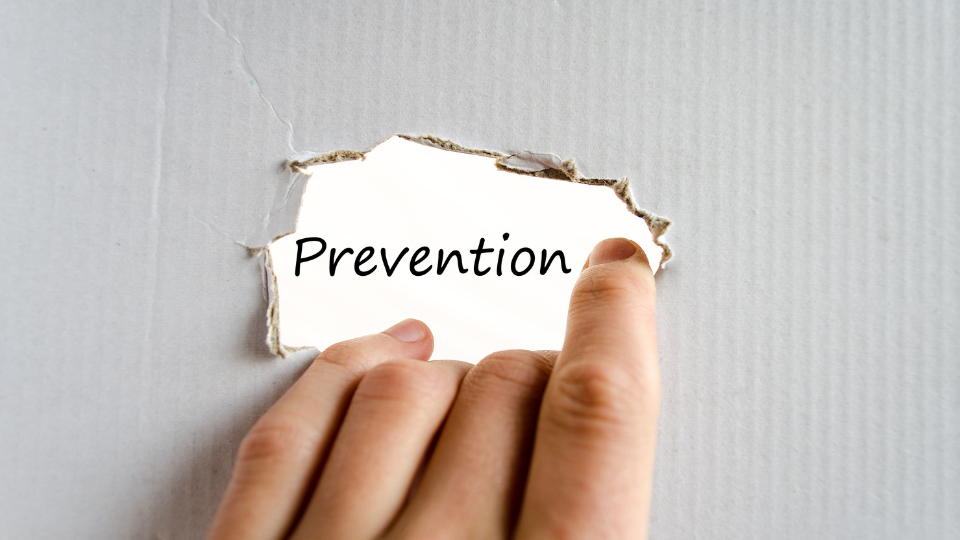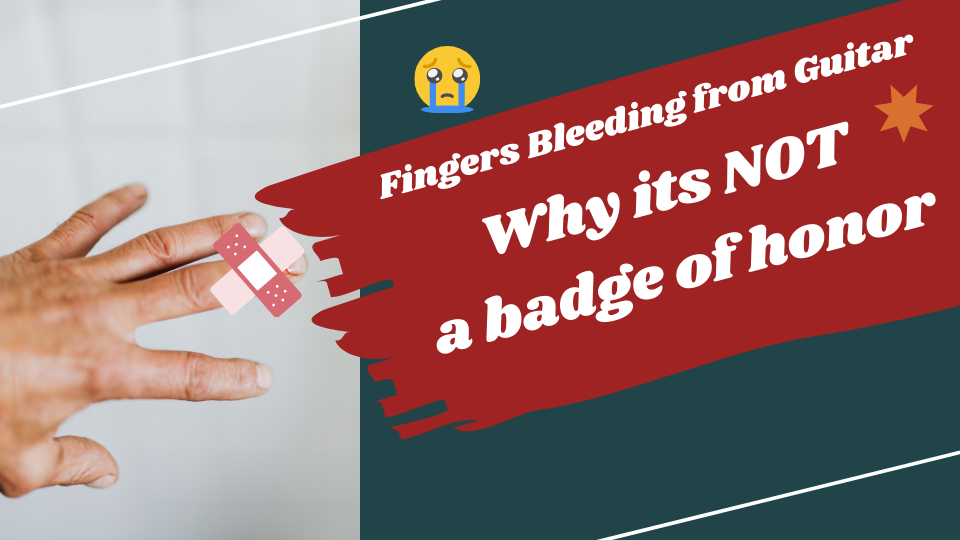This product list contains affiliate links. This means that at no extra cost to you, I may earn a commission if you use one of these links to make a purchase.
Last updated on June 26th, 2023 at 09:36 am
If you’ve ever picked up a guitar, you might be familiar with the discomfort that comes with learning to play. In fact, you might have even heard the phrase “fingers bleeding from guitar” used as a badge of honor among musicians. It’s a common belief that enduring this pain is a sign of dedication and a stepping stone to mastery. However, this article aims to challenge that notion. Instead of glorifying the pain, we’ll explore why it’s crucial to prevent fingers bleeding from guitar from happening and how to take care of your hands while learning to play the guitar.
The Medical Implications of Fingers Bleeding from Guitar

When it comes to playing the guitar, the phrase “no pain, no gain” can often be taken too literally. Continuous guitar playing without proper care can lead to potential long-term damage to the fingers, nerves, or skin. The primary keyword, “fingers bleeding from guitar,” is not just a phrase but a real issue that many guitarists face.
The skin on our fingertips is sensitive, and continuous friction from guitar strings can cause it to wear down, leading to painful sores or even bleeding. If not properly cared for, these minor injuries can escalate, potentially causing long-term nerve damage or skin conditions.
According to medical professionals and physiotherapists specializing in musicians’ injuries, it’s crucial to take preventative measures early on. Ignoring the initial signs of discomfort can lead to more serious issues down the line. For instance, continuous pressure on the fingertips can lead to nerve compression, resulting in conditions like carpal tunnel syndrome.
On the flip side, the process of callus formation, a natural response to repeated friction or pressure, can be beneficial for guitarists. Calluses provide a sort of natural ‘armor’, protecting the skin from further damage. However, it’s important to allow calluses to form gradually, giving your skin time to heal and adapt to the new pressure.
In essence, while some discomfort is part of the process of learning to play the guitar, it’s important to distinguish between the normal process of callus formation and potentially harmful damage. Proper care and attention can ensure that your passion for music doesn’t come at the cost of your physical health.
Personal Experiences and Stories
When it comes to the journey of mastering the guitar, the phrase “fingers bleeding from guitar” is all too familiar to many musicians. It’s a shared experience that binds guitarists together, a rite of passage that many believe is a testament to their dedication. However, it’s essential to understand that this doesn’t have to be the norm.
Take John, for instance, a seasoned guitarist who recalls his early days of playing. “I remember my fingers bleeding from guitar strings during my first few weeks of practice. I thought it was a sign of hard work and dedication, but it was actually a sign that I was pushing myself too hard,” he shares. John’s solution was to take regular breaks and use a specific type of moisturizing cream recommended by a fellow musician. This not only helped his fingers heal but also allowed him to practice more efficiently.
Similarly, Maria, a professional guitar teacher, shares her experience. “I’ve seen many students come in with their fingers in a terrible state. They believe it’s a badge of honor, but it’s not. It’s a sign that they’re not taking care of themselves,” she explains. Maria now makes it a point to teach her students about the importance of finger care, proper technique, and the use of guitar finger protectors to prevent such issues.
These stories highlight a crucial point: listening to your body is paramount. Pain is your body’s way of signaling that something isn’t right. Ignoring this signal and pushing through the pain can lead to unnecessary harm. It’s essential to take precautions, listen to your body, and understand that fingers bleeding from guitar playing is not a necessary step in your musical journey. It’s a sign that you need to adjust your practice and take better care of your hands.
Detailed Prevention Tips

When it comes to preventing your fingers from bleeding while playing the guitar, there are several effective strategies you can employ. These methods not only protect your fingers but also enhance your playing experience.
Properly Taping Your Fingers
One of the most common and effective ways to prevent your fingers from bleeding is by taping them. Here’s a step-by-step guide on how to do it:
- Choose the Right Tape: Opt for a breathable, flexible, and adhesive tape. Sports tape or medical tape are excellent choices.
- Clean Your Fingers: Before applying the tape, ensure your fingers are clean and dry. This helps the tape stick better.
- Wrap the Tape: Start wrapping the tape around the tip of your finger, moving downwards. Ensure it’s snug but not too tight to restrict blood flow.
- Secure the Tape: Once you’ve covered the necessary area, cut the tape and press it down to secure it.
Using the Right Cream
Applying a moisturizing cream to your fingers can help heal the skin faster and prevent it from cracking. Look for creams that contain ingredients like aloe vera or vitamin E, which are known for their healing properties. Apply the cream after each practice session and before bed to give your skin ample time to absorb it and heal.
Guitar Finger Protectors
Guitar finger protectors are a great tool for beginners who are still developing their calluses. These silicone caps fit over your fingertips, providing a barrier between your skin and the guitar strings. They can be easily fitted and removed, making them a convenient option for those long practice sessions.
Taking Breaks and Listening to Your Body
While it’s important to practice regularly to improve your guitar skills, it’s equally crucial to take breaks and listen to your body. If your fingers start to hurt, take a break. Pushing through the pain can lead to more severe damage and longer healing times. Remember, playing the guitar should be an enjoyable experience, not a painful one.
By incorporating these prevention tips into your routine, you can continue to enjoy playing the guitar without the fear of your fingers bleeding. Remember, the key is consistency and patience. It might take some time, but your fingers will eventually adapt, making your guitar playing experience much more comfortable and enjoyable.
Guitar Selection and Setup
Choosing the right guitar and setting it up properly can significantly reduce the likelihood of your fingers bleeding from guitar playing. It’s not just about the hours you put into practice, but also about the instrument you’re using and how it’s configured.
Firstly, the type of guitar matters. Acoustic guitars, especially those with steel strings, can be tougher on the fingers compared to electric guitars. If you’re a beginner and your fingers are bleeding from playing an acoustic guitar, you might want to consider starting with an electric guitar. The strings are usually lighter and easier to press down, reducing the potential for finger damage.
Secondly, the type of strings you use can also make a difference. Lighter gauge strings are easier on the fingers and can be a good choice for beginners. As you build up calluses and finger strength, you can gradually move to heavier strings if desired. Nylon strings, often used on classical guitars, are also a softer option that can be easier on your fingers.
Lastly, the setup of your guitar can impact your fingers. This includes the action of the guitar, which is the distance between the strings and the fretboard. If the action is too high, you’ll need to press down harder on the strings, which can lead to sore fingers or even bleeding. A professional guitar setup can ensure the action is at an optimal level, making it easier to play and reducing the risk of finger damage.
Remember, playing the guitar should be a joy, not a pain. Choosing the right guitar, using appropriate strings, and ensuring your guitar is properly set up can go a long way in preventing your fingers from bleeding and making your guitar playing experience more enjoyable.
Also read : What Happened To Agile Guitars?
Exploring Alternative Techniques
Playing the guitar doesn’t have to be synonymous with bleeding fingers. By exploring alternative techniques, you can protect your fingertips while still achieving excellent results. In this section, we will discuss different playing styles, finger positions, and picking techniques that can help prevent finger bleeding and promote enjoyable guitar playing.
Playing Styles
- Fingerstyle Technique: Fingerstyle playing involves using the fingers, rather than a pick, to pluck the strings. This technique distributes the force more evenly across the fingertips, reducing the risk of cuts and abrasions.
- Hybrid Picking: Hybrid picking combines the use of a pick and fingers to pluck the strings. By incorporating the fingers, you can alleviate some of the pressure on the fingertips, minimizing the chances of bleeding.
Finger Positions
- Proper Finger Placement: Positioning your fingers correctly on the fretboard can make a significant difference in preventing finger bleeding. Ensure that you’re pressing down on the strings with the tips of your fingers, rather than the pads. This reduces the friction and pressure on the fingertips.
- Lighter Touch: Avoid excessive force when pressing down on the strings. Many beginners tend to apply more pressure than necessary, leading to finger injuries. Practice finding the right balance between enough pressure to produce clear notes and a lighter touch that avoids unnecessary strain on the fingers.
Picking Techniques
- Alternate Picking: Alternate picking involves using a downstroke followed by an upstroke consistently. This technique promotes efficiency and control, reducing the need for excessive force and minimizing the risk of finger bleeding.
- Economy Picking: Economy picking combines alternate picking with sweeping motions across multiple strings. By utilizing smooth and efficient movements, you can reduce strain on the fingers and minimize the chance of bleeding.
Remember, mastering alternative techniques takes practice and patience. Start slowly, focusing on proper technique, and gradually increase your speed and complexity. Don’t hesitate to seek guidance from a guitar instructor who can provide valuable insights and help refine your technique.
By exploring alternative playing styles, adjusting finger positions, and adopting efficient picking techniques, you can enjoy playing the guitar without the unnecessary pain and risk of finger bleeding.
Also read : 8 Best Guitar Picks For Metal
The Psychological Aspect of Enduring Pain

Playing the guitar is often associated with the idea of enduring pain as a testament to dedication and passion. However, it’s crucial to understand the psychological aspect of this phenomenon and explore healthier ways to approach learning and mastering the guitar without causing physical harm.
The Importance of Mindset and Learning
- Acknowledge the initial discomfort: Learning any new skill involves challenges, and playing the guitar is no exception. It’s natural to experience some level of pain and discomfort during the initial stages.
- Emphasize the importance of a positive mindset: Encourage aspiring guitar players to approach the discomfort with a positive attitude. Rather than viewing it as an inevitable sacrifice, emphasize the joy of learning and the sense of accomplishment that comes with progress.
- Avoid glorifying pain: Challenge the notion that enduring pain is a badge of honor. Highlight that pain should not be the primary focus of guitar playing, and it’s not a prerequisite for becoming a skilled guitarist.
Psychological Strategies for Managing Pain
- Set realistic expectations: Help readers understand that progress takes time, and it’s important to set achievable goals. Discourage pushing through excessive pain and encourage a balanced approach to practicing.
- Practice mindfulness: Introduce the concept of mindfulness and how it can help manage pain and discomfort. Encourage readers to stay present in their practice sessions, paying attention to their body and making adjustments as necessary.
- Take breaks and listen to your body: Emphasize the significance of taking regular breaks during practice sessions. Encourage readers to listen to their body’s signals and rest when needed to prevent overexertion and potential injuries.
Expert Insights on the Psychological Aspect
- Include quotes or insights from a psychologist or music teacher who specializes in the psychological aspects of learning and performing music.
- Discuss their perspective on how the mind-body connection plays a role in enduring pain and the importance of finding a balance between pushing boundaries and taking care of oneself.
Also read : Guitar Picking Shoulder Pain: The Ultimate Guide
Conclusion
In conclusion, understanding the truth behind fingers bleeding from guitar playing is crucial for every guitarist. It’s time to debunk the myth that bleeding fingers are a badge of honor. Instead, let’s prioritize our physical health while pursuing our passion for playing the guitar. Here’s a recap of the main points covered in this comprehensive article:
- The medical implications of continuous guitar playing without proper care can lead to long-term damage to the fingers, nerves, or skin.
- Personal experiences and stories from fellow guitar players emphasize the importance of listening to our bodies and taking necessary precautions.
- Detailed prevention tips, including proper finger taping, using moisturizing cream, taking breaks, and utilizing guitar finger protectors, can help prevent fingers from bleeding.
- Guitar selection and setup play a significant role in minimizing finger damage, so choose the right guitar and string type and ensure proper setup.
- Exploring alternative techniques, such as different playing styles and finger positions, can be effective in preventing finger bleeding.
- The psychological aspect of enduring pain for the sake of learning or mastering the guitar should be approached mindfully. Seek a healthy balance between dedication and self-care.
Remember, it’s essential to prioritize our well-being as guitar players. By following the tips and advice provided in this article, we can enjoy playing the guitar without the unnecessary pain and risk of bleeding fingers.


